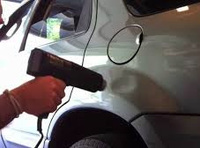
How to Pop Out a Dent Yourself - Simply Using a Heat Gun and Compressed Air!
30th Jun 2015

Do you have a dent in your car that looks bad, but really don’t want to spend the money to get fixed? If the dent doesn’t have a crease in it, you just may be able to fix it yourself with a “paintless dent removal” (PDR) trick.
PDR utilizes a variety of techniques to “pop out” dents and dings, and has been around for decades. Traditional bodywork used to be the only way to fix body damage. That job involved pounding out the sheet metal with a hammer, or using a sheet metal pull, and then required body filler and paint to complete. PDR is an art that typically involves using specialized wand-like tools to push the dent out from the backside of the body panel. If these tools need to be used it's best to leave the job to a pro, otherwise you may end up doing damage that exceeds the original ding or dent. Good PDR folks can work magic.
There is another PDR trick called “metal shrinking” that is pretty neat, and removes dents through heating and cooling of the sheet metal. This works with dents that measure at least a few inches across. Smaller dents like door dings, and hail damage will need the PDR tools. Keep in mind the result is often good, and a dent can become almost indistinguishable. However, a perfect job is usually only attained by those well trained in PDR. So, the result of this do-it-yourself metal shrinking technique may be just fine for an aged daily driver, but maybe less so for a new car or cherished classic.
To do the job you’ll need a hair dryer, or heat gun and a can of compressed air (like that used to blow dust out computers). Use the dryer or gun to heat up the dent and an area a couple of inches around the perimeter of the dent area of the dent. Keep the heat source moving to avoid damaging the paint. You also want to be sure not to overheat any adjacent plastic or rubber bits. After about 3-5 minutes of heating immediately quench the heated area with the can of compressed air – holding the can upside down while spraying. A layer of ice will form over the dent - when the ice begins to melt the dent should pop out. If not, dry the area and repeat the heating and cooling process as needed. Note: Little taps with the side of your fist around the area outside the dent can help it to pop out.

